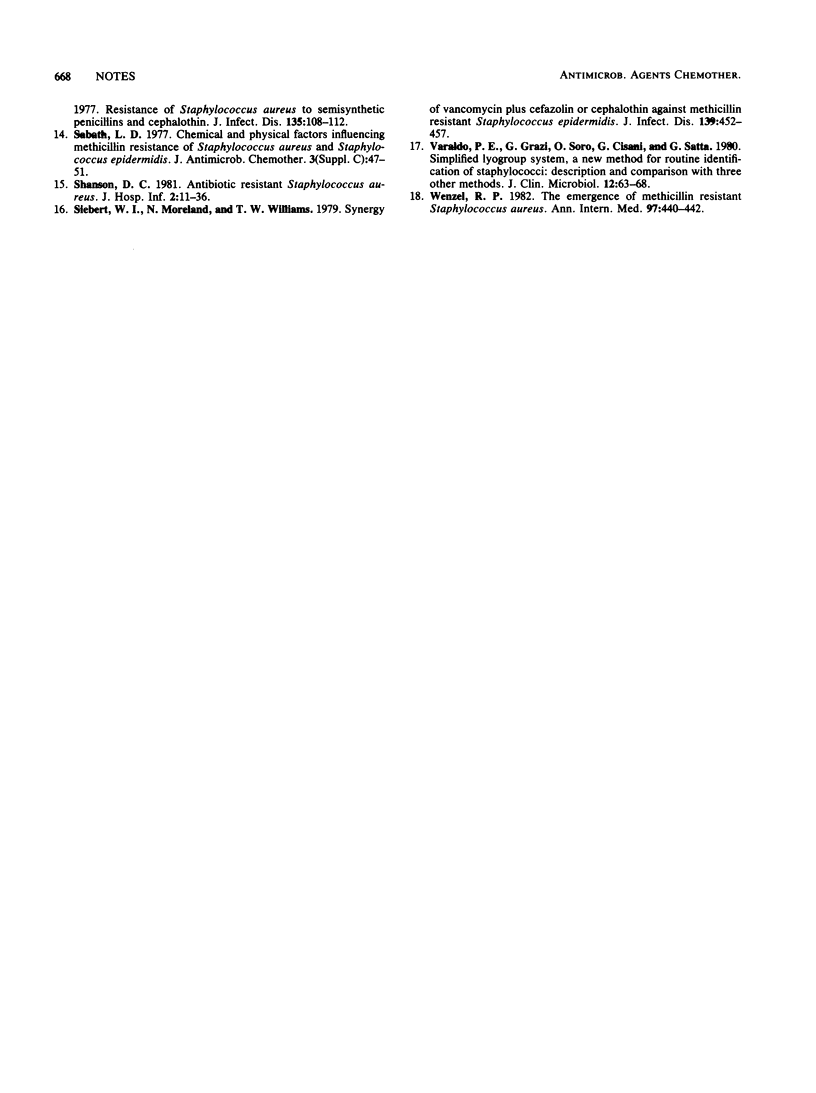Abstract
The antibacterial activity of cefamandole was evaluated against 120 methicillin-susceptible and methicillin-resistant Staphylococcus aureus and coagulase-negative staphylococcal strains, using both large (10(8) CFU per ml) and small (10(4) CFU per ml) inocula. Cefamandole appeared superior to cephalothin against methicillin-resistant strains, displaying at 10 micrograms/ml a bacteriostatic and for some strains a bactericidal action against a large inoculum of bacteria.
Full text
PDF


Selected References
These references are in PubMed. This may not be the complete list of references from this article.
- Archer G. L. Antimicrobial susceptibility and selection of resistance among Staphylococcus epidermidis isolates recovered from patients with infections of indwelling foreign devices. Antimicrob Agents Chemother. 1978 Sep;14(3):353–359. doi: 10.1128/aac.14.3.353. [DOI] [PMC free article] [PubMed] [Google Scholar]
- Archer G. L., Tenenbaum M. J. Antibiotic-resistant Staphylococcus epidermidis in patients undergoing cardiac surgery. Antimicrob Agents Chemother. 1980 Feb;17(2):269–272. doi: 10.1128/aac.17.2.269. [DOI] [PMC free article] [PubMed] [Google Scholar]
- Crossley K., Loesch D., Landesman B., Mead K., Chern M., Strate R. An outbreak of infections caused by strains of Staphylococcus aureus resistant to methicillin and aminoglycosides. I. Clinical studies. J Infect Dis. 1979 Mar;139(3):273–279. doi: 10.1093/infdis/139.3.273. [DOI] [PubMed] [Google Scholar]
- John J. F., Jr, McNeill W. F. Activity of cephalosporins against methicillin-susceptible and methicillin-resistant, coagulase-negative staphylococci: minimal effect of beta-lactamase. Antimicrob Agents Chemother. 1980 Feb;17(2):179–183. doi: 10.1128/aac.17.2.179. [DOI] [PMC free article] [PubMed] [Google Scholar]
- Kayser F. H. Methicillin-resistant staphylococci 1965-75. Lancet. 1975 Oct 4;2(7936):650–653. doi: 10.1016/s0140-6736(75)90129-4. [DOI] [PubMed] [Google Scholar]
- Klimek J. J., Marsik F. J., Bartlett R. C., Weir B., Shea P., Quintiliani R. Clinical, epidemiologic and bacteriologic observations of an outbreak of methicillin-resistant Staphylococcus aureus at a large community hospital. Am J Med. 1976 Sep;61(3):340–345. doi: 10.1016/0002-9343(76)90370-3. [DOI] [PubMed] [Google Scholar]
- Lacey R. W. Can methicillin-resistant strains of Staphylococcus aureus be treated with methicillin? Lancet. 1974 Jan 19;1(7847):88–89. doi: 10.1016/s0140-6736(74)92302-2. [DOI] [PubMed] [Google Scholar]
- Laverdiere M., Peterson P., Verhoef J., Williams D. N., Sabath L. D. In vitro activity of cephalosporins against methicillin-resistant, coagulase-negative staphylococci. J Infect Dis. 1978 Mar;137(3):245–250. doi: 10.1093/infdis/137.3.245. [DOI] [PubMed] [Google Scholar]
- Laverdiere M., Welter D., Sabath L. D. Use of a heavy inoculum in the in vitro evaluation of the anti-staphylococcal activity of 19 cephalosporins. Antimicrob Agents Chemother. 1978 Apr;13(4):669–675. doi: 10.1128/aac.13.4.669. [DOI] [PMC free article] [PubMed] [Google Scholar]
- Locksley R. M., Cohen M. L., Quinn T. C., Tompkins L. S., Coyle M. B., Kirihara J. M., Counts G. W. Multiply antibiotic-resistant Staphylococcus aureus: introduction, transmission, and evolution of nosocomial infection. Ann Intern Med. 1982 Sep;97(3):317–324. doi: 10.7326/0003-4819-97-3-317. [DOI] [PubMed] [Google Scholar]
- Sabath L. D. Chemical and physical factors influencing methicillin resistance of Staphylococcus aureus and Staphylococcus epidermidis. J Antimicrob Chemother. 1977 Nov;3 (Suppl 100):47–51. doi: 10.1093/jac/3.suppl_c.47. [DOI] [PubMed] [Google Scholar]
- Shanson D. C. Antibiotic-resistant Staphylococcus aureus. J Hosp Infect. 1981 Mar;2(1):11–36. doi: 10.1016/0195-6701(81)90003-7. [DOI] [PubMed] [Google Scholar]
- Siebert W. T., Moreland N., Williams T. W., Jr Synergy of vancomycin plus cefazolin or cephalothin against methicillin-resistance Staphylococcus epidermidis. J Infect Dis. 1979 Apr;139(4):452–457. doi: 10.1093/infdis/139.4.452. [DOI] [PubMed] [Google Scholar]
- Varaldo P. E., Grazi G., Soro O., Cisani G., Satta G. Simplified lyogroup system, a new method for routine identification of staphylococci: description and comparison with three other methods. J Clin Microbiol. 1980 Jul;12(1):63–68. doi: 10.1128/jcm.12.1.63-68.1980. [DOI] [PMC free article] [PubMed] [Google Scholar]
- Wenzel R. P. The emergence of methicillin-resistant Staphylococcus aureus. Ann Intern Med. 1982 Sep;97(3):440–442. doi: 10.7326/0003-4819-97-3-440. [DOI] [PubMed] [Google Scholar]


